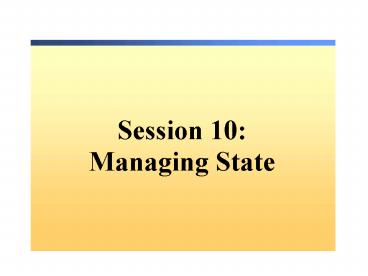Session 10: Managing State - PowerPoint PPT Presentation
1 / 16
Title:
Session 10: Managing State
Description:
User can delete cookies. Less secure than server-side state management options ... Creating and Reading Session Cookies ... used to create a persistent cookie ... – PowerPoint PPT presentation
Number of Views:279
Avg rating:3.0/5.0
Title: Session 10: Managing State
1
Session 10Managing State
2
Overview
- State Management
- Types of State Management
- Server-Side State Management
- Client-Side State Management
- The Global.asax File
- Application and Session Variables
- Initializing and Using Application and Session
Variables - Application and Session Variable Duration
- Cookies and Cookieless Sessions
3
What is State Management?
Without State Management
With State Management
Login.aspx
Login.aspx
Please enter your logon information
Please enter your logon information
First Name
First Name
John
John
Last Name
Last Name
Chen
Chen
Web Server
Submit
Submit
Web Server
Greetings.aspx
Greetings.aspx
Hello
Hello John Chen
I forget who you are!!
4
Types of State Management
5
Server-Side State Management
- Application state is a global storage mechanism
accessible from all pages in the Web application - Session state is limited to the current browser
session - Values are preserved through the use of
application and session variables - Scalability
- ASP.NET session is identified by the SessionID
string
Web Server
Client Computer
Application and Session variables
SessionID
6
Client-Side State Management
- Uses cookies to maintain state
- Persistent cookies
- Temporary/ Non-persistent cookies
- Less reliable than server-side state management
options - User can delete cookies
- Less secure than server-side state management
options - Limited amount of information
- Client-side restrictions on file sizes
Web Server
Client Computer
Cookies
7
The Global.asax File
- Only one Global.asax file per Web application
- Stored in the virtual root of the Web application
- Used to handle application and session events
- The Global.asax file is optional
8
The Global.asax File (continued)
Client
Request
Response
ASP.NET Web Server
IIS
ASP.NET HTTP Runtime
Application_BeginRequest
Application_AuthenticateRequest
Application_AuthorizeRequest
Application_EndRequest
Application_ResolveRequestCache
Application_UpdateRequestCache
Application_AquireRequestState
Application_ReleaseRequestState
Application_PreRequestHandlerExecute
Application_PostRequestHandlerExecute
Page execution
9
Initializing Application and Session Variables
- Variables are initialized in Global.asax
- The Application object shares information among
all users of a Web application - The Session object stores information for a
particular user session
Sub Application_Start(s As Object,e As EventArgs)
Application("NumberofVisitors") 0 End Sub
10
Using Application and Session Variables
- Set session and application variables
- Read session and application variables
Session("BackColor") "blue" Application.Lock() A
pplication("NumberOfVisitors")
1 Application.UnLock()
strBgColor Session("BackColor") lblNbVisitor.Tex
t Application("NumberOfVisitors")
11
Application and Session Variable Duration
- Session variables have a set duration after last
access - Default is 20 minutes
- Session duration can be changed in Web.config
- Application variables persist until the
Application_End event is fired
ltconfigurationgt ltsystem.webgt ltsessionState
timeout"10" /gt lt/system.webgt lt/configurationgt
12
Creating and Reading Session Cookies
- You can create and read session cookies by using
the Cookies Property of the Response Object and
Request Class. - Creating a Cookie
- Reading a Cookie
Dim objCookie As New HttpCookie(myCookie,
Hello!) Response.Cookies.Add(objCookie)
Response.Write(Request.Cookies(myCookie).Value)
13
Creating and Reading Persistent Cookies
- A persistent cookie is similar to a session
cookie except that a persistent cookie has a
defined expiration date - The code below can be used to create a persistent
cookie - Persistent cookies can be read in the same way as
you would a session cookie
Dim objCookie As New HttpCookie(myCookie,
Hello) objCookie.Expires 12/25/2007 Response
.Cookies.Add(objCookie)
To create a persistent cookie, specify the
expiration time
Response.Write(Request.Cookies(myCookie).Value)
14
Retrieving Information from a Cookie
- Read the cookie
- Retrieve values from the cookie
Dim objCookie As HttpCookie Request.Cookies("myC
ookie")
lblTime.Text objCookie.Values("Time") lblTime.Fo
reColor System.Drawing.Color.FromName
_ (objCookie.Values("ForeColor")) lblTime.Back
Color System.Drawing.Color.FromName
_ (objCookie.Values("BackColor"))
15
Using Cookieless Sessions
- Each active session is identified and tracked
using session IDs - Session IDs are communicated across client-server
requests using an HTTP cookie or included in the
URL - Cookieless sessions
- Session ID information is encoded into URLs
- Cannot use absolute URLs
- Most browsers limit the URL size to 255
characters, which limits use of cookieless
Session IDs
http//server/(h44a1e55c0breu552yrecobl)/page.aspx
16
Setting Up Cookieless Sessions
- Session state is configured in the ltSessionStategt
section of Web.config - Set cookieless true
ltsessionState cookieless"true" /gt































